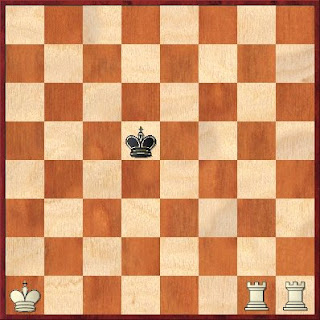It is white to move. The first instinct for a lot of players is to call check, but this is a mistake. The first thing we want to do is create a box for the Black king. That means using one of the rooks to first trap the king. Remember week 12, we talked about trapping. If you look at the below diagram the rook has made a box for the Black king after 1.Rg4
Now Black's king can never walk further up the board, he can either move backwards or travel along the 5th rank. Lets make a move for Black, say 1...Ke4.
The rook on g4 is busy stopping the king moving out of his box. Imaging this as a prison and the g4 rook as the prison guard. Now what?
Make the box or prison smaller. Leave the g4 rook guard where he is and get his lazy side kick into play. If the g4 rook is the guard, we call his partner the hunter. The hunter can call check, but remember the aim is to make Black's king's box smaller and smaller until he runs out of board. The rook calls check along the 5th rank to push the king even further back up the board. After 2.Rh5+
The Black king is in check, he can not move forward, so must move backwards. For example 2..Ke6
Black's king can now only move on the 6th rank or backwards. The rook on h5 is now the guard. If you imaging the rooks are climbing up stairs. They take turns being the guard and hunter. Once their guard duties have been taken over they can become the hunter and look for a check. The g4 rook's guard duties have been taken over by the h5 rook, so he is the hunter and looks for the next check shrinking the Black king's box. 3.Rg6+
Black moves 3...Kf7
WARNING, WARNING. Rook under attack alert!
Do not get careless, or over excited and play 4.Rh7+, because 4...Kxg6 makes Whites job a lot more difficult. The rook on g6 is under attack, so must be moved. The g6 rook is the guard and must maintain his guard duties along the 6th rank. Best is to move the attacked rook as far away from the Black king as possible. White therefore plays 4.Ra6
Black's king's box is still firmly in place. Black ties 4...Kg7
The rook on h5 is the hunter and needs to find a check along the 7th rank. 5.Rh7?? obviously lets the king take the rook, so the hunter rook first has to move to the other side of the board ready to call check next move. Move the rook as far away from the Black king as possible, but do not move onto the same file as the guard rook, as the rooks would then be in each others way. White's best move is 5.Rb5
The hunter rook on b5 will check on b7 next go and then his partner will finish climbing the stairs by calling checkmate on a8. There is nothing the black king can do. 5...Kf7 6.Rb7+
6...Ke8 7.Ra8#
Remember
- First make a box for the enemy king
- Next the rooks swap roles, climbing the stairs call check in turn making the enemy king's box smaller and smaller.
- If one of the rooks is attacked move it as far from the king as possible, without placing the rook on the same rank (or file) as his partner rook.
---------------------------------------------------------------------------
Contact me at darlingtonchessclub@gmail.com if you- Spot any mistakes with this post,
- Would like to help run Darlington Junior club
- Want any advice on creating a junior club
- Have any coaching ideas












No comments:
Post a Comment